How to Start Profitable Kienyeji Chicken Farming in Kenya. Download FREE Business Plan
Kienyeji chicken is a broad name used for indigenous chicken breeds in Kenya, mostly reared in the village under the free-range method. They are also referred to as village chicken or road runners in other regions.
Farming Kienyeji is becoming popular in Kenya today because the chicken is considered organic and hence the preferred healthier option.
Kienyeji chicken farming can bring in good returns or lead to great losses. We did a survey among 50 Kienyeji poultry farmers asking them to tell us their challenges. One farmer exclaimed,
“I am feeding them with zero returns ! ”.
Is kienyeji chicken farming profitable? You may be asking. Kienyeji chicken can be profitable if you run your chicken farming enterprise like a business, with a proper chicken business plan. In this article, we look at exactly that. How to make your chicken farming worth your time and money. We will also guide you on developing a business plan that will work for your Kienyeji chicken farm.
NB: The Kienyeji Chicken Farming Business Plan is available for download at the bottom of this article.
The case for Kienyeji Chicken
Before starting your own kienyeji chicken venture, you will need to ask yourself one question. Why? Why go into chicken farming? Why keep Kienyeji chicken instead of hybrid broilers or layers?
There are several reasons why farmers consider keeping kienyeji chicken. These are:-
- Ease of entry – It is very easy to start rearing Kienyeji chicken. No much initial capital is required, especially if you are doing it as a hobby or trial. Getting one rooster(male chicken) and two hens are enough to start. When the hens start laying, let them sit on eggs. If each hen hatches 10 chicks, and is let to brood them for 2 months, then lay for another month, you should have at least 60 chicken at the end of one year. Assuming zero mortality and no chicken is disposed of, you should have hundreds of Kienyeji chicken by the end of the second year.
- The hardiness of kienyeji chicken – Kienyeji chicken are known to be hardy. They have better resistance to disease than hybrid chicken. When it comes to feeding, they can forage for their own feed. Some breeds are known to have the ability to survive on agricultural waste alone. With hybrid chicken have to feed on a well balanced well-formulated feed ration throughout in order to achieve maximum productivity.
- Increased demand for Kienyeji eggs and Kienyeji meat – As Kenyans become more health-conscious, there is increased demand for Kienyeji eggs and meat. There are are perceived to be more healthy. The growing niches such as purely free-range chicken, antibiotic-free chickens, improved kienyeji chicken, etc.
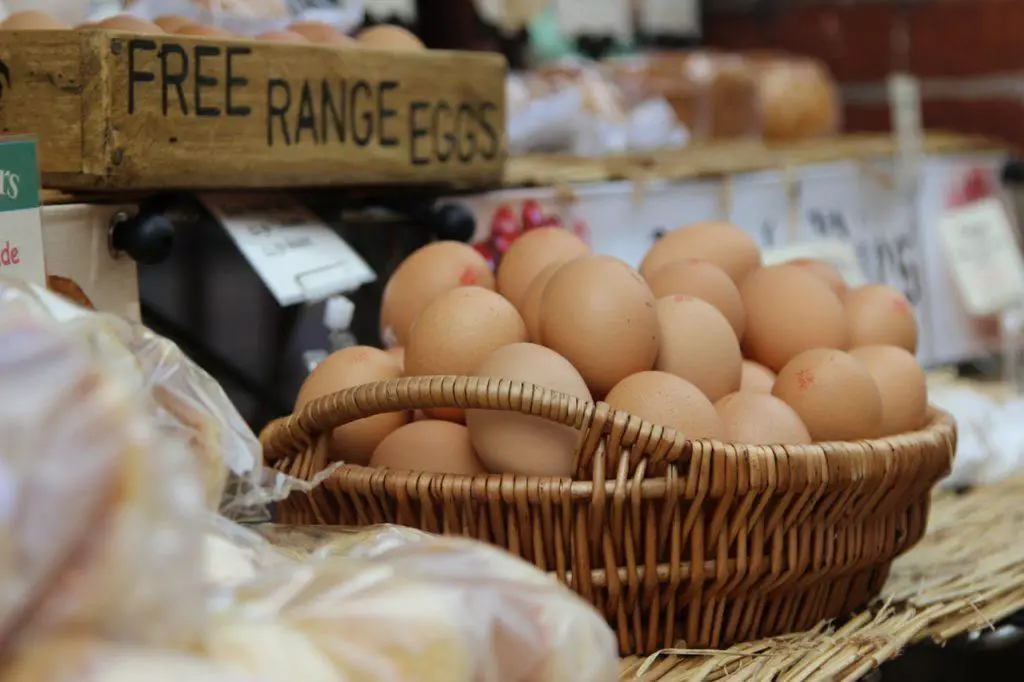
Free Range Eggs
Origin of the improved Kienyeji Chicken
Most Kienyeji chicken have been overbred, leading to lower productivity. This is both to lower productivity both in the number of eggs and average weight gain
Research by the Food and Agriculture Organization(FAO) of the United Nations, recorded that village chickens lay an average of 23 eggs per year (In Gambia) and an average of 123 eggs per year (Ethiopia). The difference in numbers from Gambia and Ethiopia is because in Ethiopia, farmers we found to interfere with the laying cycle, by discouraging brooding.
It is also very hard to have performance indicators for village chickens e.g it is hard to know the expected number of eggs at a certain age, or the expected weight at let’s say 4 months.
These challenges led to a number of organizations, in Kenya and abroad to undertake research to improve the village (kienyeji) chickens. The goals of the research was to develop a chicken breed:-
- That has the good qualities of Kienyeji chicken
- That has a higher productivity
- Where it is possible to track performance.
- That matures faster.
The several distinct researches came up with chicken breeds with improved by either:-
- Breeding Indegenous breeds with hybrid chickens.
- Breeding Indegenous breeds that have good qualities with other indegenous breeds that have good qualities.
Improved Kienyeji Breeds
There are 5 common improved Kienyeji breeds in Kenya. These are
Developed by Kenya Agricultural and Livestock Research Organization by breeding Local village chicken that had the best qualities.
2. Rainbow Rooster Improved Kienyeji
Developed by IndBro in India, as a part of a government-funded program to improve the livelihood of rural low-income earners. Rainbow rooster is imported to Kenya by KukuChic Limited, who hatch the eggs and sell chicks across the country
3. Kuroiler
Kuroiler is imported to Kenya via Uganda, where there is a hatchery for F1 at Entebbe, Uganda. Kuroiler was first developed in India. Most of the Kuroiler sold in Kenya will either be F2 or F3 and will not be as productive as the F1 Kuroilers.
4. Kenbro
Kenbro is sold by Kenchic Limited and is meant to be the replacement of the Kienyeji chicken.
5. Sasso – Sasso chicken, named after the company that developed them in France is meant to be a free-range broiler, that can also be kept under the intensive system.
Farming methods for Kienyeji Chicken
Traditionally, Kienyeji chicken have been kept under the extensive system, where they are let free to scavenge for their own feed. Once in a while, the feed is supplemented by giving the chicken grains. With this method, there is minimal medication and access to veterinary officers.
The chicken are housed on temporary structures and in some cases spend the night with other livestock or in the room that is not used by the farmer’s family at night, for example, the kitchen.
There is no protection from predators. With this traditional system, the flock never gets to grow big, where the farmer can benefit from economies of scale. There is no flock management, but the farmer sells chicken when he needs to. Though the costs are very minimal in this system, there is no way to measure profitability.
A solution to these issues is to keep the Kienyeji chicken, using modern poultry farming methods, while reaping the benefits of the traditional system, e.g keeping the costs down.
The modern systems of poultry farming are:-
- Free-range system –
Under the free-range system, the chicken are left to roam around the farm and scavenge for their own food. There is minimal or no supplementation when it comes to feeds.
The chicken are housed at night to protect them from predators and adverse weather. There are some modifications of this method of poultry farming, namely the pastured system and the yarding system.
- Semi-intensive system
Under the semi-intensive system, the chicken are kept in a fenced run, where they can roam around. The run is attached to the house where they sleep at night. Food and water are provided by the farmer.
- Intensive system
Under this system, the chicken are kept in a house or cages. Under this system, there is the deep litter system, the slatted system and the cage system. This system allows a large number of birds to be kept in a small piece of land. Food, Water, lighting and other poultry needs are provided by the farmer.
- Pastured Poultry System
Under the pastured poultry system, the chicken are kept in temporary fenced paddocks or kept in chicken tractors and moved to a new paddock every few days. They spend the night in the chicken tractors or movable coops inside the paddocks. This is a modification of the free-range system, where the chicken can scavenge for their own feed but are provided with water and security.
The paddocks are fenced using movable fences, sometimes powered by electricity so as to keep predators away and the chicken inside.
Supplemental feed is given to the chicken to meet their nutrient quota. The chicken eat insects, grass and other vegetation in the paddock. Moving the chicken allows the vegetation on the paddock to regenerate and grow again.
In some cases, the chicken follow the herbivores that have been feeding on the paddock. When the herbivores move to the next paddock, the chicken are moved to the paddock where the herbivores were. This allows the chicken to benefit from the bugs in the animal droppings. The land also benefits as the chicken spread the animal droppings when they are scratching.
- Yarding Poultry System
Yarding is similar to the pastured poultry system, but the herbivores and the chicken exist on the same paddock and are moved together to the next paddock.
- Organic Poultry System
Under the organic poultry system, either the free-range, semi-intensive, pastured or yarding systems are preferred, though the intensive system can also be used.
In this system, any substance that leaves chemical residues in the eggs and chicken meat are not used on the chicken. This includes antibiotics and insecticides. Organic methods of treatment and pest/parasite controls are used.
The recommended stocking density under the organic system is 1000 birds per hectare and not more than 2000 birds per house if the intensive system is used.
The feed must be organic and only specific non-organic additives are allowed in the feed.
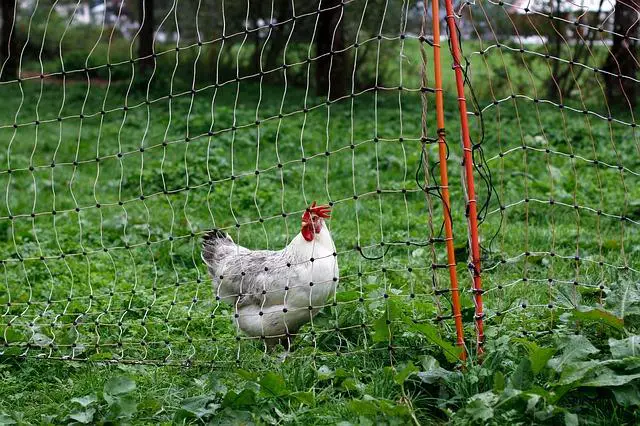
Movable fence for chicken paddocks
Housing for Kienyeji Chicken
In order to make a profit from your Kienyeji chicken business, you will need to offer them good housing. When your chicken is comfortable, they will be more productive. Below are the qualities of good housing for your Kienyeji Chicken:
- Keeps the chicken safe from predators
The house and range/chicken run should keep the chicken safe from predators.
- Free from environmental extremes like strong wind, cold and heat
Exposure to extreme environmental elements can affect your Kienyeji chicken flock negatively, leading to death, stunted growth and diseases.
- Clean and easy to clean
The chicken house should always be clean and constructed in such a way that it is easy to clean.
- Adequate Lighting
There should be enough lighting in the chicken house. Lighting affects chicken development and productivity. For laying hens, nesting boxes should be a bit dimmer and private. Construct the chicken house so that you can provide supplemental lighting if need be. Extra lighting, especially for laying hens can lead to increased productivity.
- Well Ventilated
The chicken house should have enough airflow, to allow for the birds to have clean air. It also allows for ammonia from the chicken droppings to exit the chicken house.
- Controlled Access
Not every tom, dick and harry should get into the chicken house anytime they want to. The house should be constructed in such a manner that it is easy to control who gets in and when. Anyone getting in should use a foot bath at the entrance, in order to avoid the spread of diseases.
- Ease of egg collection
The house should be constructed in such a way that the farmer will be able to collect eggs without stressing the birds, and in the least time possible.
- Separation of age and variety of birds
Separation of birds according to age and variety has several benefits, including tracking the performance of the flock, giving age-appropriate feed, vaccination and disease control. Each age group should be housed separately
- Correct stocking density
The house should have the right number of chicken. Overcrowding leads to numerous issues, culminating in less productivity.

Fenced Kienyeji Chicken House Layout with Foot Bath at the entrance. Source: KALRO
Feeding Kienyeji Chicken
A lot of research has gone into chicken nutrition, with great recommendations on nutrients for optimal performance. One of the reasons Kienyeji chickens farmers do not make a considerable profit is they leave feeding of their chickens to fate, feeding them whatever is available at any given time.
Think of chickens like human beings, who need different nutrients at different ages. Lack of these nutrients, at a specific age, will lead to low immunity, stunted growth, and impaired development. This is the same for chicken.
There is a misconception in the market that you can give your chicken one type of feed for all different ages. In the Kenyan market, it is branded as Kienyeji Mash. This would be similar to feeding a human baby the same feed e.g rice and beans from birth until they grow old.
Whether you are making your own feed or supplementing with what is available, the chicken needs specific feed mixes with specific nutrients at different ages. Chicken feed is divided into different growth stages and the purpose of the birds:
- Starter
Starter chicken feed is meant for baby chickens. They are packed with nutrients needed for the development of chicks. Starter feeds have a high level of protein of 22%-24% for meat chicks and 20% for layer chicks. If you are raising you are Kienyeji chicken for meat, you should give the starter required for meat birds, and similarly, if you are raising them for eggs, you should give then the starter feed for laying birds.
Starter chicken feed comes either in medicated form or unmedicated form. The medicated form contains antibiotics, for fighting against bacterial diseases such as coccidiosis. The unmedicated form is ideal if you are raising organic chicken.
- Grower Pullet
Grower Pullet chicken feeds are meant for teenage chicken that is being kept for laying eggs. They have 18% protein content. The lower protein content is meant for the birds to develop stronger bones, and get to the right laying weight gradually.
Too much protein will make the birds lay too early before the productive systems are well developed. This will lead to several health issues and will have a negative effect.
Grower pullet feed is fed to chickens until 14 weeks.
- Grower Pullet Finisher
Grower pullet finisher is meant to transition the laying chicken from grower pullet to layers mash. This is given to the chicken from 14 weeks to 22 weeks when they start laying. Grover pullet finisher contains 16% protein.
- Layers Mash
At about 22 weeks of age, the chicken being raised for eggs are ready for laying. At this age, they are transitioned to layers mash, which contains 16% to 18% protein and extra calcium that is needed for strong eggshells.
- Broiler Mash
Broiler mash has high protein content and is meant for chicken being raised for meat. It contains 20% protein and is meant to make the chicken gain weight. Normal broilers are slaughtered at between 6 to 8 weeks. This is not the case for Kienyeji chicken, which are usually ready for slaughter at between 4 to 6 months, depending on the breed. For Kienyeji chicken, it is recommended to transition to 16% protein after 12 weeks, until they are ready for slaughter.
- Water
Clean and fresh drinking water is one of the most important requirements for chicken. Chicken drink doubles the amount of feed they take in weight. For instance, if the chicken takes 5 grams of food, they need 10 grams of water. Less water leads to poor digestion, meaning that the feed given goes to waste and the chicken farmer will not achieve the desired results.
Vaccination Schedule for Kienyeji Chicken
Kenya Agricultural and Livestock Research Organization (KALRO) recommends vaccination against Marek’s disease, Newcastle disease, Infectious bronchitis, Gumboro, Fowl Pox, Fowl Typhoid and Deworming.
You can download the Kienyeji chicken vaccination schedule here. This should be adequate for both the Kienyeji and Improved Kienyeji breeds.
Purpose of a Kienyeji Chicken Farming Business Plan
A chicken business plans to organize your thoughts
A chicken farming business plan will help you put your thoughts on the chicken farming business in a structured way. Most of the time we have good business ideas but without structuring the ideas it will be hard to bring them to life.
Chicken business plans help you to validate your thoughts on paper
A chicken farming business plan will help you give a closer look into your idea. When you put the plan in writing it will help you know what will work and what will not. Validating your idea on paper will help you reduce the risk of pursuing the wrong opportunity.
An example is that you might think keeping chicken for eggs is more profitable, but when you put it on paper, you might find based on your target market area, keeping chicken for meat might provide good profits and quick cash flow. You might have thought that supplying eggs to institutions around your area is better, but when you put the idea on paper, you find out that consumers in your area prefer farm fresh organic eggs and are willing to pay more for them than the institutions.
Most of the time, our ideas are based on assumptions. Putting the ideas on paper helps us validate these assumptions, establishing what will work and what might need to be streamlined.
A business plan will also help you uncover new opportunities that you might not have identified before.
A chicken business plan helps you stay on track
A chicken farming business plan acts as a road map that will help you achieve the envisioned success. Since the business plans have an outlook of three to 5 years, you will not be swayed by every new fad that comes your way.
A well researched and thought out business plan will act as the lighthouse that leads you to the shores of success.
A chicken business plan helps you to prepare for the future
A chicken business plan gives you a long term outlook for your kienyeji chicken farming business. It will help you know what to expect 6 months into the future when your chicken starts laying. It will help you handle the challenges that come with the business and seize new opportunities that come your way. Opportunity favors the prepared.
Establish milestones for your chicken farming business.
Milestones are those important stages that your chicken business will pass through. They are markers of success. What will success look like in six months, one year, three years or five years?
Milestones encourage you to stay on course as you pursue your plan. They might be based on achieving certain production metrics or a certain income level.
A chicken farming business plan helps you understand your competition.
One of the issues with any business is competition. A well thought out plan will help you know what your competition is doing and what you can do to get their market share. What can you do better than them? Is it customer service? packaging? delivery?
To better understand your customer.
To whom will you be selling the products from your chicken business? What is important to them? As they say, the Customer is King. A chicken business plan will help you better understand your customers and how to serve them.
Sometimes we think of starting a chicken farming business because of what we like or want. I might like fluffy pillows made of soft chicken feathers. But the question is does the customer want the same? Will they be willing to pay for it?
What is the age of your customers? How often do they need your product? Do they prefer yellow yolk free-range chicken eggs or layer eggs? What is important to them? Price or Quality? Answering this and many other questions will help you know exactly who you will be dealing with and how to meet them at their point of need.
A chicken business plan helps document your revenue model
Show me the money. You might be starting the business to meet a specific need but at the end of the day, it is about making profits. How will you make money? This is one of the major questions your chicken farming business plan will be answering.
You will be offering value to your customers and they will be paying for that value. A revenue model will help you determine how to get the most value to your customers. This in turn will translate to your customer providing revenue to your business.
A chicken business plan helps you know how much money you need.
A business plan helps you know how much money you will require to start your business and keep it running. The startup cost is the amount of money you will be required to start the chicken farming business up to the point that the business starts bringing in revenue. An example would be the cost of constructing the poultry house, cost of chicks, or cost of drinkers and feeders.
Whether you are keeping chicken for eggs, note that you will not make money until you sell the product. You will be spending money up to that point. This money will need to come from somewhere. You do not want to start keeping chicken for eggs and give up on the fourth month since you cannot afford to buy their feed.
A chicken business plan will help you know exactly how much you will need. Note that this might vary depending on different conditions. An example is if the cost of feed increases at a certain season. A business plan will help you plan for this.
A chicken business plan helps you attract investors
Where will the money to start and run your chicken farming business come from? How will you convince the source that it is worthwhile?
Whether you are financing the business yourself or borrowing money from friends and family, or getting loans from the bank, you need to have a well-written plan of how much you need, how you will spend it and how you will make more money to offset the money put into the business. This is in addition to making a profit that will be worthwhile investing in the chicken farming business.
A chicken business plan helps force you to research and understand your market
A poultry farming business plan will help you know your market and how to produce for them. If your customer buys eggs based on price, you will know how to control your production so that you can sell a price your customer will be comfortable with.
You need to realize that sometime your customer might not be the consumer. If your target market is supermarkets and shops, you need to sell to them at a price where they will also be able to make a profit after selling the product from your chicken farm.
A chicken business plan identifies who to partner with.
The partners for your chicken farming business will include day-old chick suppliers, feed suppliers, agro vets, vets among many others. A business plan will help you identify these partners in your area how they operate and how to work with them.
You might find it cheaper to partner with a feed supplier who delivers chicken feed to your farm than having to go to the shops and buy. Hatcheries that supply day-old chicks might need you to book in advance. In case of a disease outbreak, are there vets in your area that you can call on short notice?
A business plan will let you know who you need to partner with in order to achieve success in your business.
A chicken business plan will help you know who you need to hire
How much work will be needed to be done on the chicken farm? Who will do this work? What are their qualifications? Will they work fulltime or parttime?
A business plan helps identify the staff you will need on your farm and their skill sets. It will also help you identify the cost associated with these employees.
also read
HOW TO START AND BECOME A SUCCESSFUL POULTRY FARMER
We are fixing a reported issue on downloading the business plan. Please check back in a few days

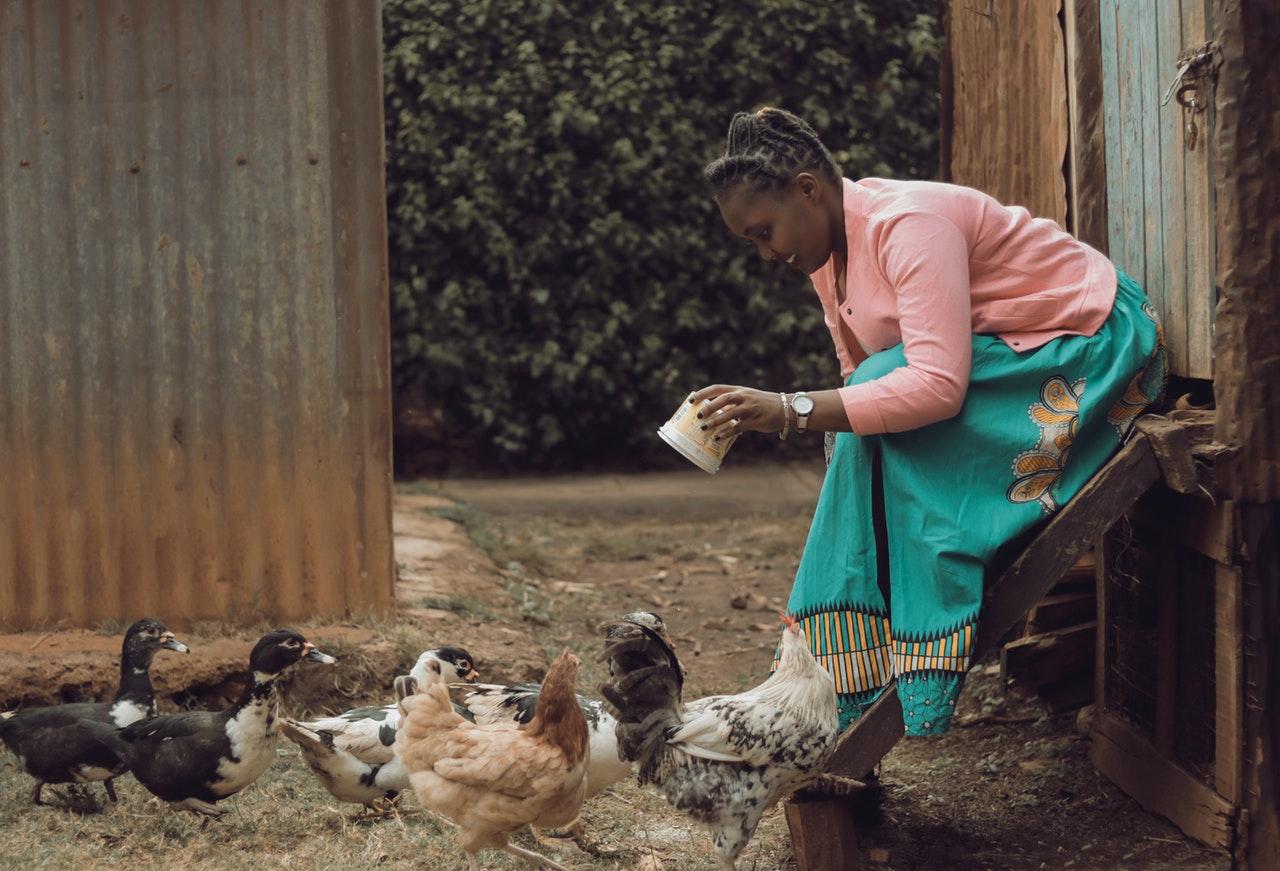
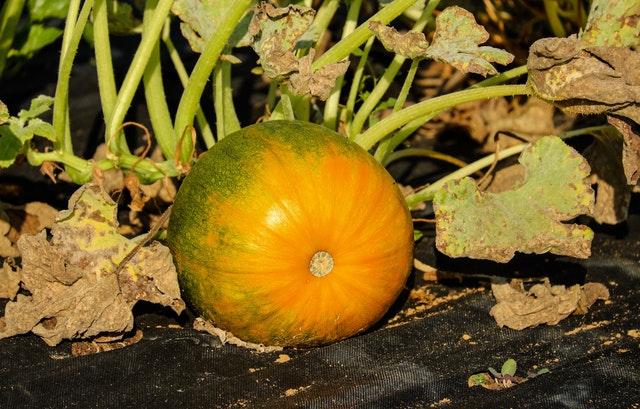
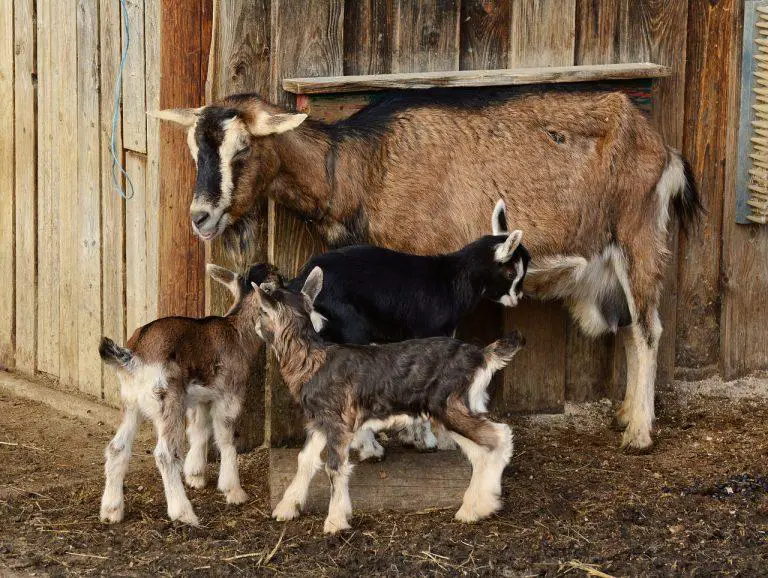
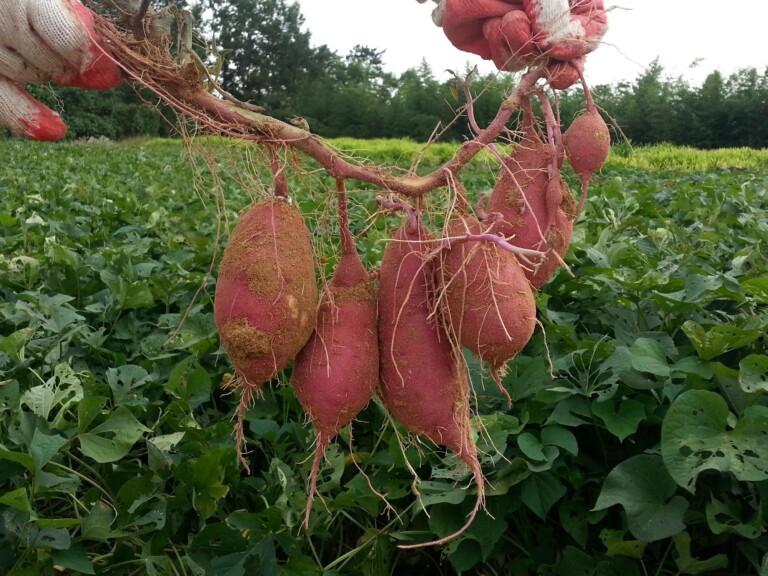
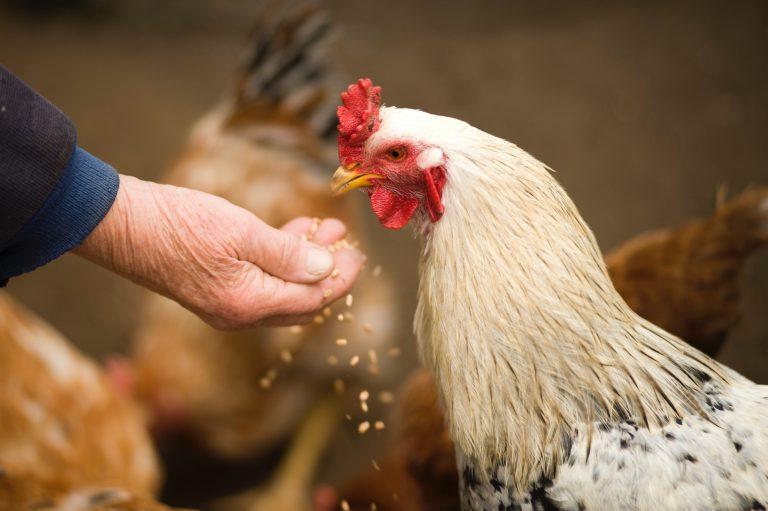
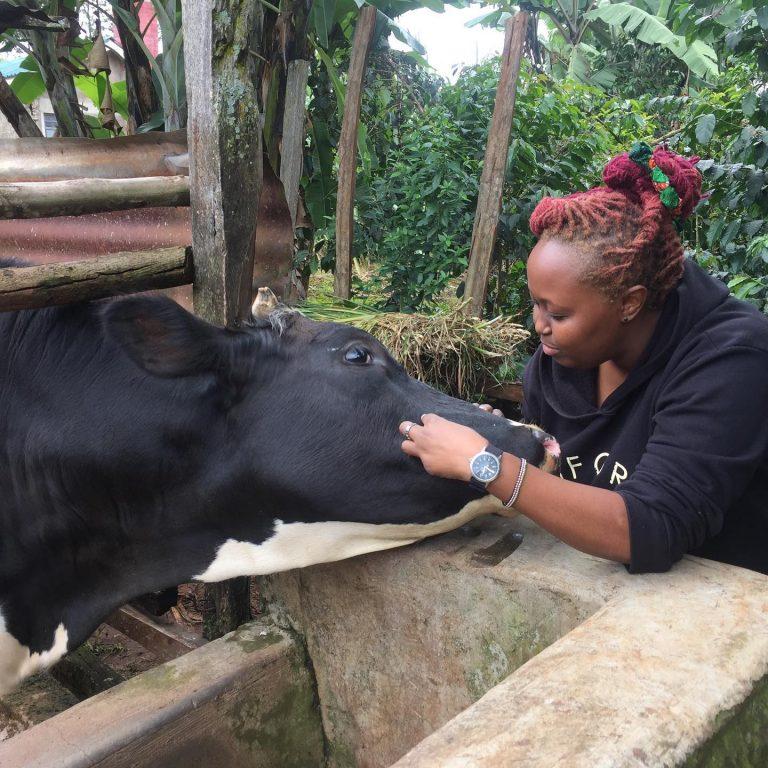
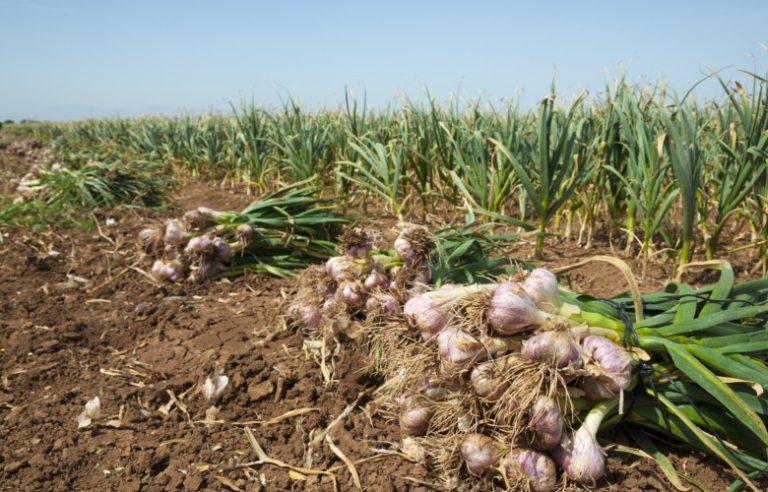
I must say this information is very informed. I’ve really gained a lot here.
Am encouraged to start and…
Am encouraged to start and run my firm
A very useful information,…
A very useful information, and am motivated to venture into this business
Good website for peasant…
Good website for peasant agro- farmers to gain and skills. Thanks
very informative
very informative
Very good and timely info on…
Very good and timely info on kienyeji chicken farmimg
This is a very good article…
This is a very good article. have been looking for information like this in vain
Hi i need to know how much…
Hi i need to know how much and where i can get 3 weeks old chicks of
KARLO kienyenji
Joyce
kasarani Nairobi
This is a good article and…
This is a good article and thanks alot cos i have learned so much on Kienyeji chicken farming. How can i please downloading the business plan ?
Job well done,pongezi for…
Job well done,pongezi for the good work you’re doing in educating us better farming methods, I have already started with few kienyeji chicken and I want to grow,thanks and continue.
Thank you the article is…
Thank you the article is very informative, I look upon to start kienyeji farming very soon after gaining alot from this article
Thanks for the information
Thanks for the information
Very good job,thanks. Your…
Very good job,thanks. Your article has most of the information a farmer needs to do the care.
kindly share with us…
kindly share with us different feed formulation for different stages of both kiemyeji and other chicken. You can still do for mixing of 70kg
On the previous page, you…
On the previous page, you gave us a simple guide on making 70kg of Chick mash,Grower mash, layer mash, broiler starter,broiler finishes and kienyeji mash.
The Chick mash ,Grower mash and Layers mash indicated above are they for kienyeji chicken or for other chickens (kuku wa grade)?
Do we have kienyeji formulation for different kienyeji stages?
Please read the section on …
Please read the section on “Feeding Kienyeji Chicken” above.
Thanks for the information,…
Thanks for the information, however i have looked for the feeding schedule for kuriolers on intensive system but i could not find. kindly share with as well.
Hi
I need 200 3 weeks old…
Hi
I need 200 3-week old KARLO chicks. I will appreciate it if you could also confirm all feeds required to maturity including medication. Do you sell feeds too? Can you deliver these to Chuka, Tharaka Nithi County?
Kindly confirm and share your affordable costs
Regards
kubai
Interested with kienyeji…
Interested with kienyeji farming
Good idea for we small…
Good idea for we small farmers if one follow the steps given at last will get profit
Can we start keeping them as groups then be assisted?
Very informative. Hope i…
Very informative. Hope i change my kienyeji way of rearing kienyeji chicken.
Good job comrades,I have…
Good job comrades,I have just started my kienyeji chicken farm,I expect to get more from you.Thank you
Hello, my question is how I…
Hello, my question is how I can get sasso breed in Kenya, siaya county, ugunja sub county
Check the list if SASSO…
Check the list of SASSO Chicken suppliers here https://value.co.ke/article/sasso-chicken-breeds-details-and-management-information